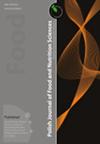食品工艺中合成抗氧化剂对脂质代谢和生物利用度影响的体外研究
IF 2.3
4区 农林科学
Q3 FOOD SCIENCE & TECHNOLOGY
引用次数: 2
摘要
合成抗氧化剂,如丁基羟基甲苯(BHT)、丁基羟基茴香醚(BHA)和叔丁基对苯二酚(TBHQ),多年来已被广泛用于稳定食品中的脂质。尽管如此,它们对用它们稳定的脂质的生物利用度和代谢的影响仍然未知。为了研究这个问题,对不含抗氧化剂并补充BHT、BHA和TBHQ(100mg/kg)的模型高脂肪产品(20g脂肪/100 g)进行了体外消化,然后使用Caco-2和Hep G2细胞系进行了研究。BHT、BHA和TBHQ增加了三酰甘油的肠道吸收并改变了乳糜微粒(CM)的结构。BHT和TBHQ的加入抑制了载脂蛋白IV(apoA-IV)的合成。同时,分泌出较小的乳糜微粒,但其数量比不含抗氧化剂的模型产品中的要多。相反,BHA激活apoA-IV合成,导致形成较少但非常大的CM。令人担忧的是,使用BHT和TBHQ后,细胞中apoA IV显著降低,这可能导致肥胖,因为在食用用这些抗氧化剂稳定的高脂肪食物后缺乏饱腹感。此外,肝细胞摄取CM残余物(CMR)的效率与其大小呈负相关。BHA样品产生的大CMR没有被肝细胞吸收,这可能导致动脉粥样硬化。我们的体外研究结果为食品技术中使用的合成酚类抗氧化剂作为潜在肥胖和动脉粥样硬化诱因的作用提供了新的线索,并表明需要进一步研究,将促进这些疾病发展的抗氧化剂与不促进这些疾病发展的抗氧化剂明确区分开来。本文章由计算机程序翻译,如有差异,请以英文原文为准。
Influence of Synthetic Antioxidants Used in Food Technology on the Bioavailability and Metabolism of Lipids - In Vitro Studies
Synthetic antioxidants, such as butylated hydroxytoluene (BHT), butylated hydroxyanisole (BHA), and tert-butylhydroquinone (TBHQ), have been widely used for many years to stabilise lipids in foods. Nonetheless, their effect on the bioavailability and metabolism of lipids stabilised with them still remains unknown. To investigate this issue, in vitro digestion of a model high-fat product (20 g fat/100 g) without antioxidants and supplemented with BHT, BHA and TBHQ (100 mg/kg) was conducted, followed by studies using the Caco-2 and Hep G2 cell lines. BHT, BHA and TBHQ increased intestinal absorption of triacylglycerols and modified the structure of chylomicrons (CM). The addition of BHT and TBHQ inhibited apolipoprotein-IV (apoA-IV) synthesis. At the same time, smaller chylomicrons were secreted, but their amount was greater than in the model product without antioxidants. In contrast, BHA activated apoA-IV synthesis, resulting in the formation of fewer but very large CMs. Of concern was the significant decrease in apoA-IV in cells upon the use of BHT and TBHQ, which can lead to obesity due to the lack of the sensation of feeling full after eating high-fat foods stabilised with these antioxidants. Furthermore, the efficiency of CM remnant (CMR) uptake by hepatocytes was inversely correlated with their size. The large CMRs generated for samples with BHA were not absorbed by hepatocytes, which can lead to atherosclerosis. The results of our in vitro study shed new light on the role of synthetic phenolic antioxidants used in food technology as potential obesity and atherosclerosis triggers and suggested the need for further research that will clearly separate antioxidants that promote the development of these diseases from those, which do not do that.
求助全文
通过发布文献求助,成功后即可免费获取论文全文。
去求助
来源期刊

Polish Journal of Food and Nutrition Sciences
FOOD SCIENCE & TECHNOLOGY-
CiteScore
4.30
自引率
12.50%
发文量
25
审稿时长
20 weeks
期刊介绍:
The Polish Journal of Food and Nutrition Sciences publishes original, basic and applied papers, reviews and short communications on fundamental and applied food research in the following Sections:
-Food Technology:
Innovative technology of food development including biotechnological and microbiological aspects
Effects of processing on food composition and nutritional value
-Food Chemistry:
Bioactive constituents of foods
Chemistry relating to major and minor components of food
Analytical methods
-Food Quality and Functionality:
Sensory methodologies
Functional properties of food
Food physics
Quality, storage and safety of food
-Nutritional Research Section:
Nutritional studies relating to major and minor components of food (excluding works related to questionnaire
surveys)
-“News” section:
Announcements of congresses
Miscellanea
 求助内容:
求助内容: 应助结果提醒方式:
应助结果提醒方式:


